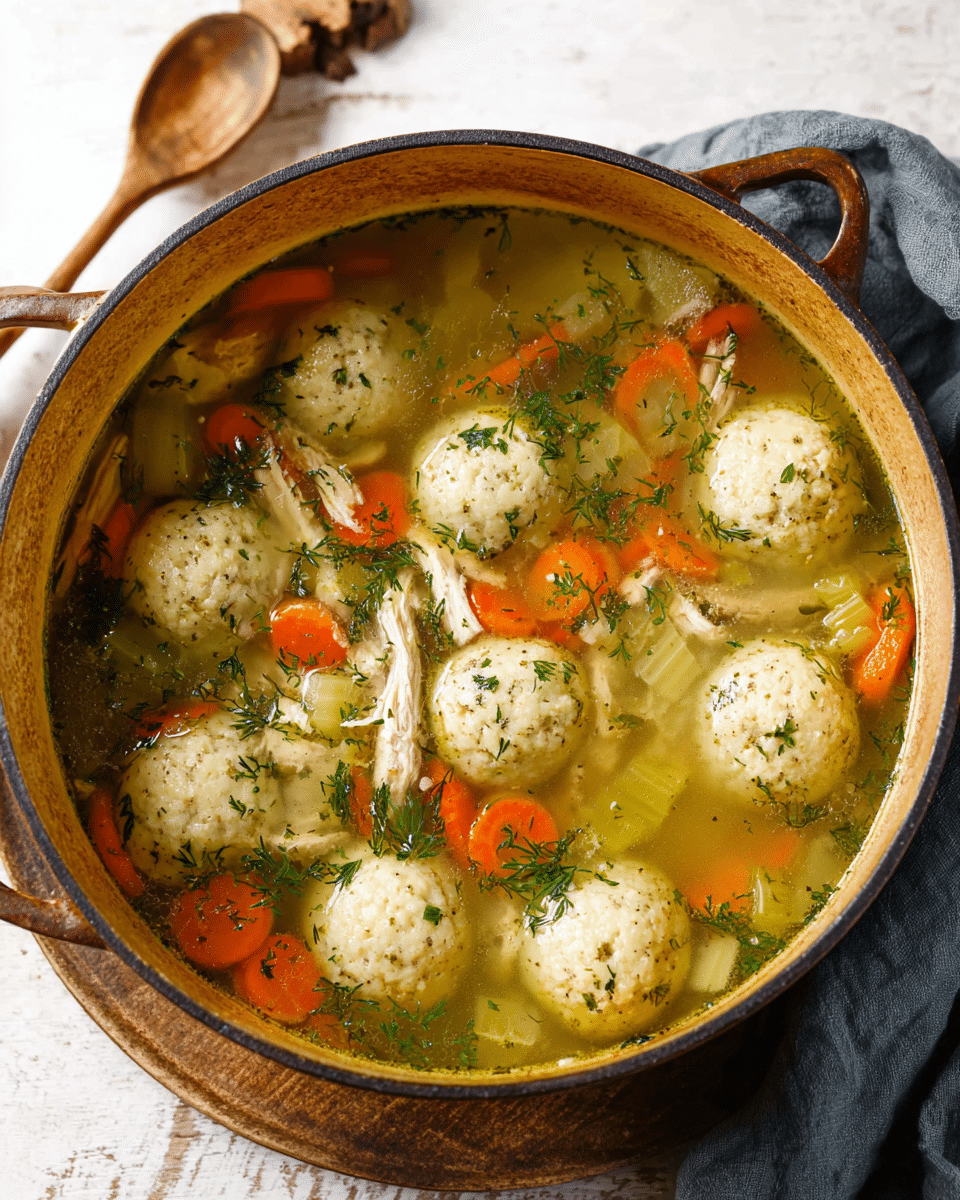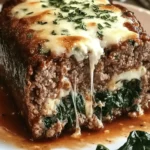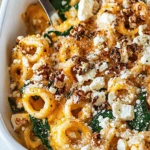The humble yet iconic Matzo Ball Soup is a comforting classic with deep roots in Jewish culinary tradition. With its golden, flavorful broth, tender chicken, and fluffy matzo balls, it’s a dish that evokes warmth, family, and healing. Whether enjoyed during Passover or on a cold winter day, this soup delivers both nourishment and nostalgia.
Perfect for home cooks looking to master a beloved recipe or share something meaningful at the table, this version combines old-world flavor with simple ingredients. The use of homemade chicken broth enriched with aromatics and herbs ensures that each spoonful is as rich in flavor as it is in history.
Full Recipe:
Ingredients:
-
1 whole chicken (about 3-4 lbs), cut into pieces
-
10 cups water
-
4 large carrots, sliced
-
3 celery stalks, chopped
-
1 large onion, peeled and halved
-
5 garlic cloves, smashed
-
1 parsnip, peeled and sliced (optional but traditional)
-
1 tablespoon kosher salt
-
½ teaspoon black pepper
-
1 bay leaf
-
Fresh dill for garnish
For the Matzo Balls:
-
1 cup matzo meal
-
4 large eggs
-
¼ cup schmaltz (rendered chicken fat) or vegetable oil
-
¼ cup sparkling water or seltzer
-
1 teaspoon salt
-
½ teaspoon garlic powder
-
¼ teaspoon pepper
Directions:
-
Place chicken in a large soup pot and cover with water. Bring to a boil, skimming off foam.
-
Add carrots, celery, onion, garlic, parsnip, bay leaf, salt, and pepper. Reduce heat and simmer uncovered for 1.5 to 2 hours.
-
Meanwhile, mix all matzo ball ingredients in a bowl. Cover and refrigerate for at least 30 minutes.
-
Strain the broth into another pot. Discard solids or shred chicken to return to soup.
-
Bring strained broth to a gentle boil. With wet hands, form matzo mixture into balls about the size of a walnut.
-
Drop matzo balls into the broth. Cover and simmer for 30–35 minutes, or until puffed and cooked through.
-
Return chicken and vegetables to soup if desired. Garnish with fresh dill. Serve hot.
Prep Time: 20 minutes | Cooking Time: 2.5 hours | Total Time: 2 hours 50 minutes
Kcal: 275 kcal | Servings: 6 servings
Matzo Ball Soup is more than just a bowl of chicken broth and dumplings it’s a warm embrace from Jewish kitchens around the world. This timeless dish has been served for generations, especially during holidays like Passover, but its appeal goes far beyond religious tradition. Whether you’re seeking comfort, fighting off a cold, or simply craving a nourishing bowl of soup, Matzo Ball Soup offers healing and flavor in every spoonful.
The Cultural Significance of Matzo Ball Soup
Matzo Ball Soup holds a deeply rooted place in Jewish culinary heritage. Traditionally made with a rich chicken broth and matzo meal dumplings (known as “kneidlach” in Yiddish), the soup is especially prevalent during Passover when leavened bread is forbidden. It evolved from dumpling-style dishes popular in Eastern European Jewish communities and remains a staple at family gatherings.
More than just a meal, it is a dish filled with memory and meaning. For many Jewish families, it’s synonymous with Friday night dinners, High Holy Day meals, or sitting at the Seder table during Passover. The making of Matzo Ball Soup can also be a ritual in itself, often passed down through generations, with each cook bringing their own twist on the tradition soft vs. firm matzo balls, clear broth vs. loaded with vegetables.
Why Matzo Ball Soup Is So Loved
One of the reasons Matzo Ball Soup is adored by so many is its universal comfort. The gentle, savory aroma of slow-simmered chicken broth infused with onion, garlic, and herbs is undeniably soothing. Matzo balls, light and fluffy or dense and hearty depending on preparation, add both texture and satisfaction.
Additionally, it’s an incredibly versatile soup. Some recipes include shredded chicken, parsnips, and fresh dill, while others stick to the essentials. Whether served as a humble meal on a chilly day or as the first course of a grand celebration, Matzo Ball Soup always fits the occasion.
The Healing Powers of Matzo Ball Soup
Often lovingly called “Jewish Penicillin,” Matzo Ball Soup is widely regarded as a remedy for colds, fatigue, and even broken hearts. While scientific studies have confirmed that chicken soup can help reduce inflammation and congestion, the healing magic of Matzo Ball Soup may lie just as much in its nostalgic, emotional comfort.
The slow-simmered broth is packed with nutrients and hydration, while the warm temperature soothes sore throats and clears sinuses. It’s also easy on the digestive system, making it a go-to for anyone recovering from illness. Add in the emotional connection memories of loved ones, family traditions, and holidays and it’s no wonder this dish is considered medicinal.
Modern Twists on a Traditional Classic
While the traditional recipe remains iconic, many modern variations of Matzo Ball Soup have emerged, allowing for creativity without losing authenticity. For example, some cooks incorporate fresh herbs like parsley and dill directly into the matzo balls for an extra punch of flavor. Others add a squeeze of lemon to the broth or roast the chicken beforehand to deepen its richness.
Vegetarian versions have also gained popularity, especially among plant-based eaters. These variations use vegetable broth in place of chicken and often add more root vegetables like carrots, parsnips, and turnips. Some vegan recipes even recreate the texture of matzo balls without eggs, using ingredients like tofu or flaxseed meal.
Gluten-free eaters can still enjoy this dish with gluten-free matzo meal substitutes, and spice lovers might add a pinch of chili or ginger to the broth for a bold twist.
Serving Suggestions and Pairings
Matzo Ball Soup is often served as a starter but can easily stand on its own as a main course when paired with challah or crusty bread (outside of Passover), a crisp salad, or roasted vegetables. During Passover, serve it alongside dishes like brisket, kugel, or gefilte fish.
To elevate the experience further, garnish with fresh dill or chopped parsley and serve with lemon wedges for an added layer of brightness. For a hearty winter dinner, a larger portion of the soup with extra chicken and vegetables can become a one-bowl meal.
Tips for Perfect Matzo Balls
Everyone has their preference fluffy or firm, small or large. The texture of the matzo ball is a topic of passionate debate in many households. For light and airy matzo balls, the trick is to use seltzer water and let the dough chill before shaping. Cooking them covered, at a gentle simmer (never a rolling boil), helps them puff up without falling apart.
If you prefer denser, more doughy matzo balls, reduce the amount of fat or seltzer and handle the dough more firmly. And always use wet hands when rolling them to prevent sticking.
Making matzo balls in advance and freezing them can also be a time-saver. Simply freeze them uncooked, and when you’re ready to use, drop them straight into the simmering broth until fully cooked.
Health Benefits of Matzo Ball Soup
This soup is not only comforting but also nutritious. The homemade broth is rich in collagen and minerals that support immune function and joint health. Chicken provides lean protein, while the vegetables deliver fiber, antioxidants, and vitamins.
Matzo balls themselves, though a bit starchy, offer a satisfying energy source. When made with healthy oils and moderate salt, they can be part of a balanced meal. The low-fat nature of the broth and its hydrating effect make it an ideal food when you’re not feeling well or when you’re looking to eat lighter.
Occasions to Enjoy Matzo Ball Soup
While Matzo Ball Soup is a must-have during Passover, it’s also perfect for Rosh Hashanah, Hanukkah, and Shabbat dinners. But don’t limit it to holidays this soup is an excellent weekday dinner, an impressive addition to a dinner party, or a soul-soothing dish to bring to a sick friend.
Its simplicity and wholesomeness make it appropriate for all ages, from toddlers to grandparents. It can also be scaled up easily, making it great for potlucks and family gatherings.
Common Mistakes to Avoid
- Boiling the matzo balls too hard: This can cause them to disintegrate or become rubbery. A gentle simmer is key.
- Not chilling the dough: Letting the matzo mixture rest in the fridge helps the balls hold their shape and cook evenly.
- Skipping the broth strain: For a clear and elegant presentation, strain your broth to remove bits and sediment.
- Overseasoning: Matzo Ball Soup should be delicately seasoned to highlight the ingredients, not overwhelm them.
Matzo Ball Soup Around the World
While it is most closely associated with Ashkenazi Jewish culture, similar dumpling soups can be found across cultures—from Chinese wonton soup to Italian chicken soup with pastina. Matzo Ball Soup’s unique character lies in its spiritual and cultural heritage. Across the U.S., Israel, and beyond, Jewish communities have kept the tradition alive, often with slight regional variations that reflect local ingredients and customs.
Conclusion
Matzo Ball Soup is a dish that speaks to the heart. Rich in tradition, flavor, and nourishment, it offers comfort and connection to heritage and home. Whether you’re preparing it for a special holiday or simply in need of a cozy meal, this classic soup delivers every time.
With endless variations, approachable techniques, and its universally loved taste, Matzo Ball Soup remains a cherished recipe in kitchens around the world. It’s more than just soup it’s a story in a bowl, a symbol of resilience and love, and the perfect meal to share with family and friends.
Whether you’re new to Jewish cooking or returning to a recipe you’ve enjoyed since childhood, Matzo Ball Soup is a beautiful reminder that food has the power to heal, connect, and comfort us all.






